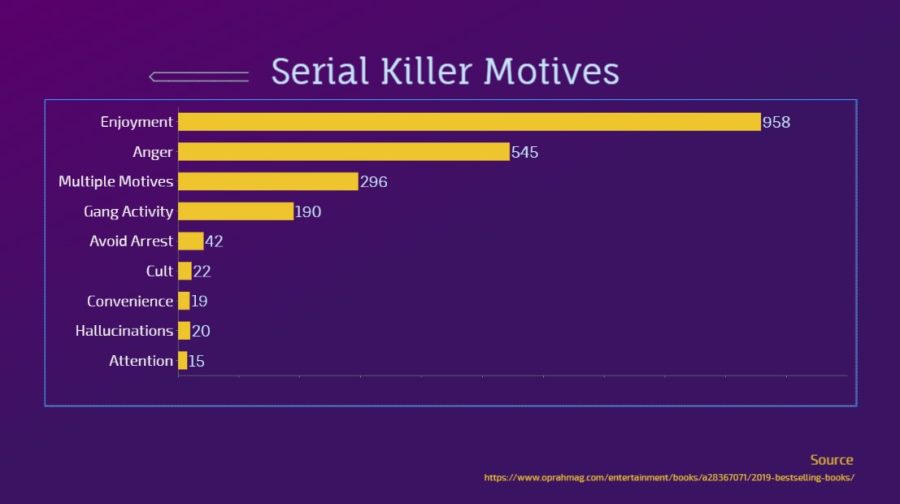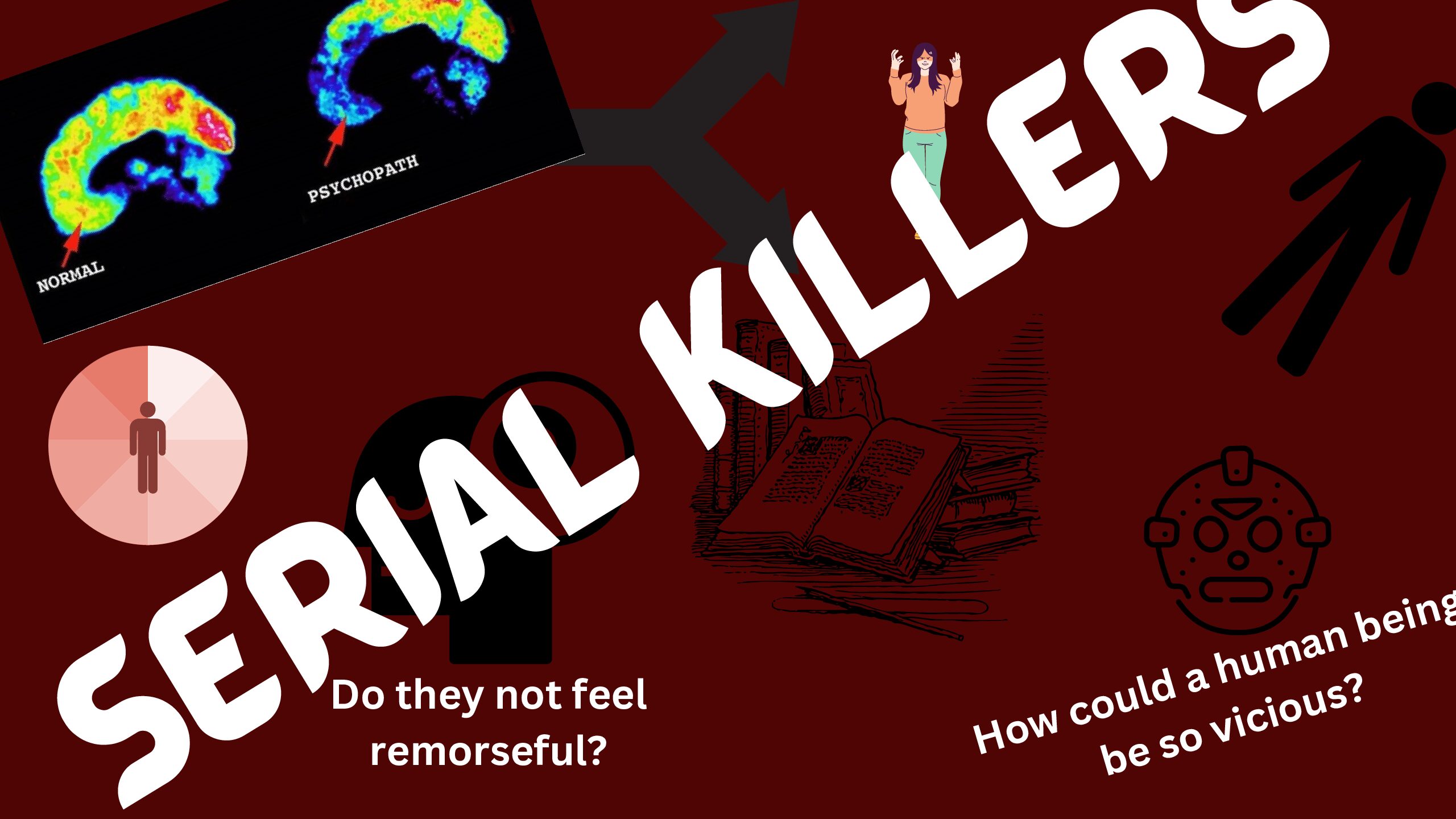The brain of a serial killer
May 15, 2023
People like Jeffrey Dahmer, Pedro Lopez and Ted Bundy have committed some of the most gruesome crimes on numerous occasions. Their actions always stunned the world because people ask, “How can a human being be so ruthless with no remorse?” While the answer remains uncertain, psychological attributes might answer their question.
Serial killers might experience trauma and neglect in their childhood, leading to the urge to commit such atrocities. Psychologists also label abuse as a contributing factor, but a majority of people who survive abuse do not become serial killers, and 32% of serial killers hold no history of abuse. Peter Vronsky has argued that in cases where no previous traumatic experience exists, serial killers choose to act on their compulsions. Dennis Rader committed the most brutal killings among all serial killers, but after authorities arrested him, they discovered he lived such an ordinary life.
People also questioned if serial killers showed signs of violence from an early age. The Macdonald triad refers to the idea of three signs that can indicate whether someone will become a serial killer or another kind of violent criminal: animal cruelty, fire setting and bedwetting. In his childhood, Dahmer experienced one out of three of these signs. Dahmer collected animals and bleached and preserved their bones; he later applied these strategies when preserving his victims.
What one receives exposure to at a young age can also dictate one’s actions as they age. Exposure to violent media, such as films, music and video games, results in an increased likelihood of violent behavior. This correlation explains why parents become highly spectacle of what their children watch and explains why children do not receive access to certain movies at theaters. This exposure can desensitize individuals to violence and normalize it in their minds, leading to aggression and violence.
Certain serial killers kill their victims in distinctive ways due to fascinations. Nobody—not even criminal psychologists— can pinpoint a serial killer’s motives. Over the years, psychologists have not identified serial killers as legally insane, but they have found them to experience an antisocial disorder. They lack empathy and remorse, show no regard for laws or social norms, and carry a strong desire to seek revenge against individuals or society. This finding explains why they can kill a multitude of people without experiencing guilt, leading them to do it again. Psychologists have also diagnosed serial killers with psychosis, schizophrenia and other personality disorders.
“I do not think their motives are justified. A large percentage of serial killers have abnormal brain function. I believe the majority of serial killers know right from wrong and moral from immoral. I think their obsessions about killing turn into compulsions that are driven by their antisocial behavior,” AP psychology teacher William Hargis said.

Serial killers might view their victims as an object to abuse or fantasize over body parts. This explains why acts of necrophilia take place, because Serial killers contain insecurities and feel compelled to kill due to a fear of rejection, which sometimes result from abandonment or abuse. They may think that by destroying the person they desire, they can eliminate the sense of abandonment and humiliation that they endured during childhood. Richard Ramirez, the American serial killer, rapist and burglar who murdered at least 13 people, did not receive enough attention from his parents. He experienced physical abuse from a young age and left to his own resources.
Psychologists also find that serial killers suffer from narcissistic personality disorder. They characterize narcissists as holding an utter lack of empathy. This phenomenon explains the continuation of serial killers’ wrong-doings. The majority of serial killers and mass murderers suffer from a pathologized form of narcissism. Society views narcissistic adults as the result of bitter disappointments, of radical disillusionment in their significant others in their infancy. All of what serial killers most likely experienced led them to their crimes.

A 2000 report by Dr. Richard Davidson at the University of Wisconsin found neuroimaging studies of those who have committed murders show a difference in brain activity, compared to those who have not. Brain scans showed reduced brain activity in areas that control emotional outbursts, violent emotions and fear responses. This study suggests that while certain serial killers may possess abnormal brain processing, no guarantee exists that differences in brain structure will result in a murderer. A brain imaging study showed that criminal psychopaths held decreased connectivity between the amygdala and the prefrontal cortex, which interprets responses from the amygdala. When connectivity between these two regions appears low, the processing of negative stimuli in the amygdala does not translate into any strong negative emotions.
The physical structure of a serial killer’s brain has also raised questions when wanting to receive a deep understanding of a serial killer’s motive. The brains of murderers typically do not look like an average human brain. Brain SPECT imaging technology measures blood flow and activity in the brain which shows areas with healthy activity, areas with too much activity and areas with little activity. Several serial killers and murderers also contain left temporal lobe abnormalities. Other scientific research confirms that temporal lobe abnormalities result in increased aggression and violence.
“I never really understand serial killers and their motives. I think much of their actions come from their childhood experiences. It makes the most sense because people who grow up in a difficult environment, find themselves projecting that anger when they get older. I don’t think there’s many actions to take in order to detect this behavior from an early age, but I do think a heavier police force can control serial killers,” junior Sunna Alam said.
Levels of serotonin might also explain the motives behind serial killers. Serotonin, a brain neurochemical that synthesizes directly within the brain, appears responsible for moods, social behavior and other key roles. After doctors tested serotonin levels for the past 40 years, they found that they correlate to abnormal aggression. They also concluded that people with low serotonin levels contain an impulsive personality. Doctors have linked low serotonin levels in the brain to poor orbitofrontal cortex function, which appears in people with antisocial behavior. This phenomenon explains the reason why serial killers find themselves lacking empathy or remorse. Low serotonin levels also correlate to other psychiatric afflictions such as pathological shyness, obsessive-compulsive disorder, anxiety, depression and certain addictions. Serotonin plays a large part in the motives of serial killers.

Serial killers have lived amongst us for ages; for as long as humans exist, serial killers will as well. While nothing will ever justify serial killers’ actions, understanding the psychology behind them will help to prevent these urges amongst people in the future. Focusing on one’s mental health and providing kids with a safe loving environment will also contribute to preventing these violent urges.
